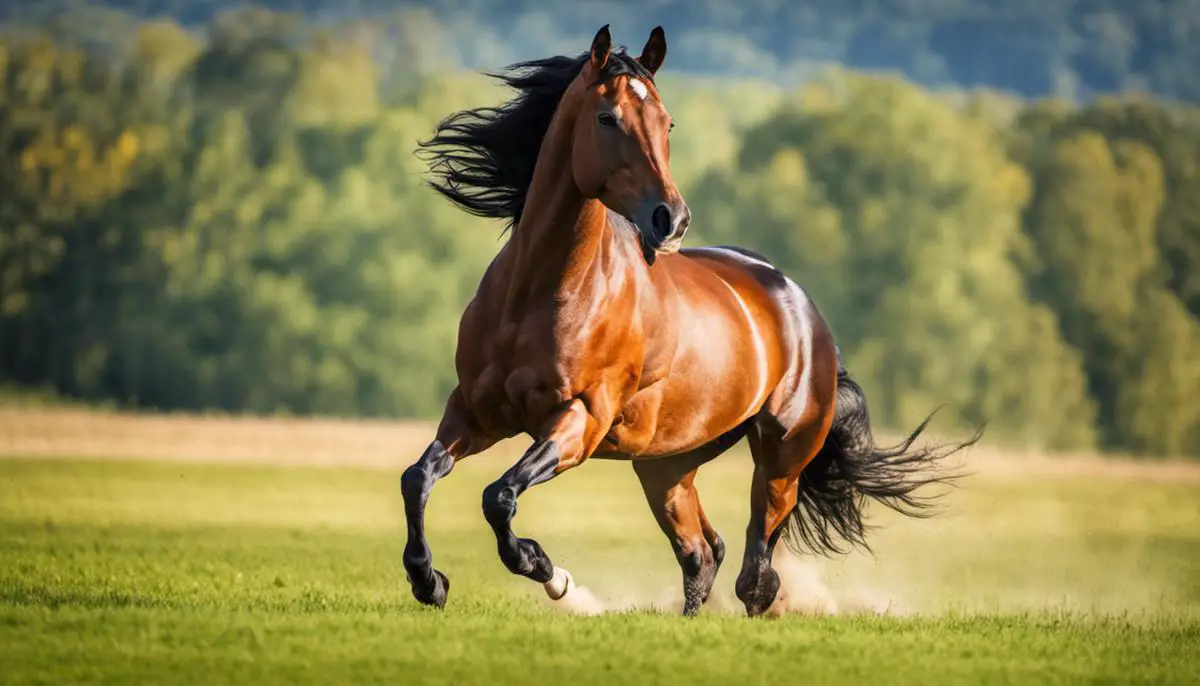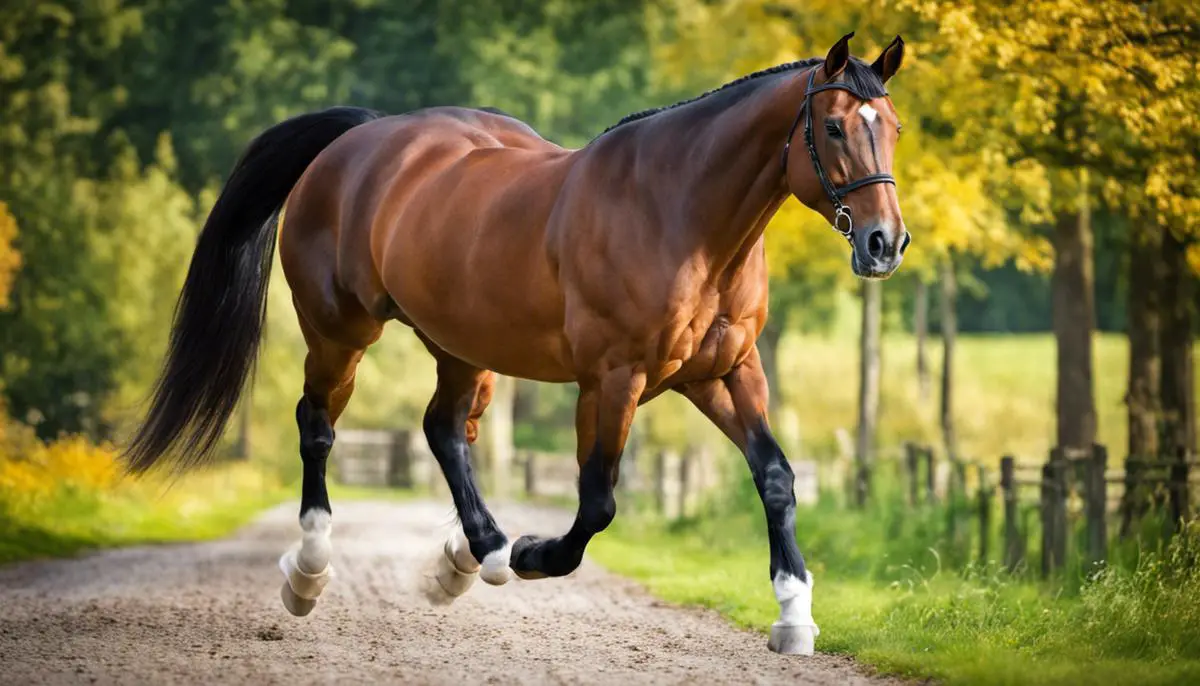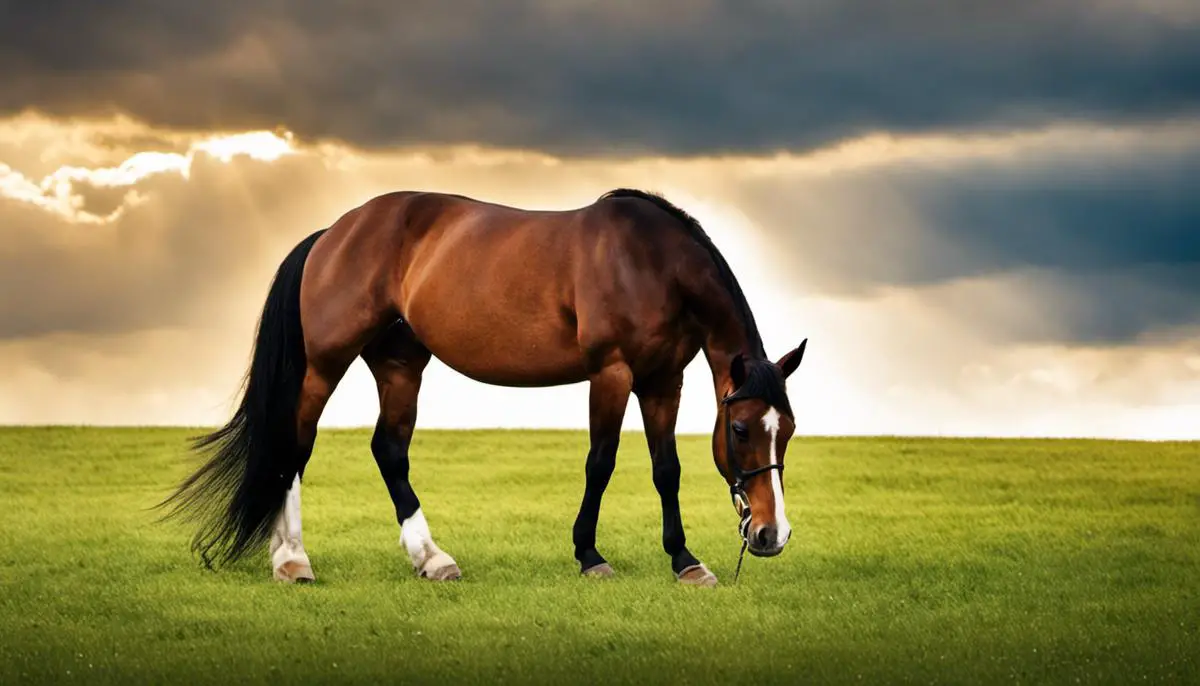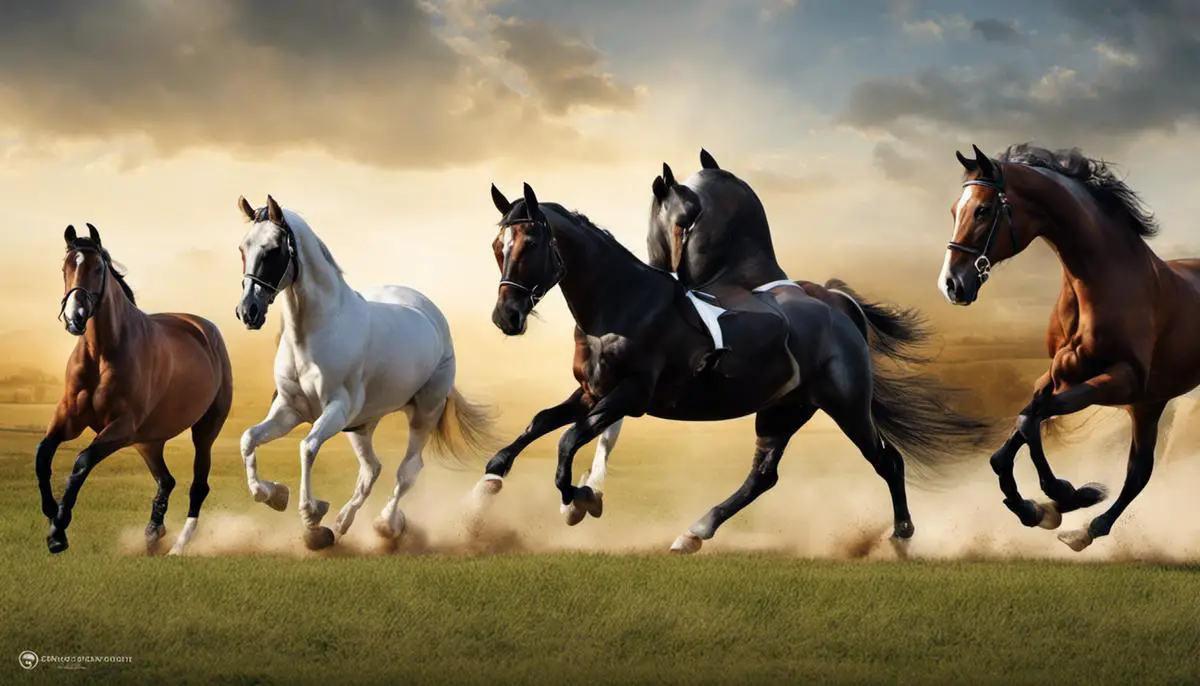Rooted in the heartlands of Germany and flourishing in equestrian arenas around the globe, the Hanoverian horse is an emblem of versatility, athleticism, and strength. Revered for its physical stamina and elegant presence, this breed is deeply embedded with fascinating history and distinctive characteristics. Being transformed from a sturdy farm horse to a resplendent sports horse, the Hanoverian’s journey is peppered with perseverant resilience and evolved breeding practices. Understanding these nuances can increase our appreciation for this magnificent creature and its integral role in equestrian sports. This discourse aims to unravel the breed history, delve deeper into its physical attributes, comprehend its multifaceted roles, and elucidate the imperative aspects of its care and maintenance, thereby offering a detailed insight into the world of the Hanoverian horse.
Table of Contents (Horspedia)
Origin and Breed History
Origin and Breed History: Hanoverian Horse
The Hanoverian horse takes its name from a former independent kingdom, Hanover, now known as Lower Saxony in modern Germany. This breed’s history traces back to the 16th century when the region was known for its superior cavalry mounts.
Originally, the Hanoverian was a high-quality carriage and military horse, bred for its power and agility. It was a robust, versatile breed, more substantial than many of today’s warmblood horses. The local farmers were known to keep meticulous breeding records, aiming to produce a horse that was both strong and tractable, with a particular emphasis on soundness and longevity.
In the late 18th century, King George II of England, who also ruled Hanover, developed the Royal State Stud at Celle to improve local stock. This public breeding institution introduced Thoroughbred and Cleveland Bay stallions to refine the local mares. Over time, this crossbreeding led to a more refined, lighter version of the original Hanoverian.
Throughout the 19th and early 20th centuries, technological advancements decreased the demand for heavy draft horses, and the Hanoverian’s breeding direction was adjusted accordingly. The studbook for the breed, started in 1888, began introducing more Thoroughbred blood to create a more athletic and versatile horse suitable for riding and lighter farm work.
Transition to Modern Hanoverian Horse
The transformation of the Hanoverian from a heavyweight all-purpose farm horse to a high-performance sport horse was extensively influenced by World War II. The war demanded horses with endurance, speed, and agility, leading breeders to again refine the Hanoverian by introducing Arabian and Thoroughbred bloodlines.
In the postwar period, as demand for working animals diminished and interest in leisure and sports riding increased, the Hanoverian’s breeding focus shifted towards excelling in show jumping, dressage, and eventing. Today’s Hanoverian is a staple in international horse shows, consistently ranking among the top performers due to its athleticism, versatility, and temperament.
Hanoverian Horse: Origins and Breed Standards
Established in 1922, the breed standard for Hanoverian horses requires a uniformity in height, temperament, and color. Ranging from 15.3 to 17.2 hands in height, these beautiful beasts can be any solid color, but are most often seen in shades of bay, chestnut, black and grey.
Managed by the “Hannoveraner Verband,” an organization formed in the same year as the breed standard, Hanoverians are subject to stringent breeding selection. This includes thorough physical inspections and performance trials, which mares and stallions must pass to earn inclusion in the Hanoverian studbook. This rigorous process helps maintain the breed’s reputation for producing superior sport horses, renowned for good health, commendable athleticism, and a high degree of trainability.

Physiology and Characteristics
Characteristics and Traits of the Hanoverian Horse
Native to Germany, the Hanoverian horse is famed for its outstanding athletic build and versatility; characteristics that make it a popular choice for a variety of equestrian activities. A mature Hanoverian can stand as high as 17.2 hands, which roughly translates to 71 inches from the base of the hoof to shoulder.
Present in an array of solid colors due to crossbreeding with other breeds, Hanoverians are most commonly found in bay, chestnut, black, and grey. While they are predominantly solid colored, you can also find Hanoverians with delicate white markings gracing their faces and legs.
Hanoverians have an impressively muscular build, contributing to their fine athletic capabilities. They boast an elegant head, a solid neck that seamlessly integrates with the shoulders, and a potent back, all core components of their formidable physical structure. They stand on strong legs with large, clean joints and hardy hooves, adding to their sturdy physique.
What distinguishes a Hanoverian is not limited to its physical traits—it’s their temperament that sets them apart. Hanoverians are smart, keen to please and easy to train, making them a perfect partner for dressage and jumping. Hanoverians are known for their calm demeanor but are driven when it comes to performing tasks, with a bold nature that brims with courage and determination.
While Hanoverians are known to shine in competitive arenas, they are also fantastic pleasure horses. Their balanced temperament and comfort under the saddle make them an excellent choice for both professional and recreational riders.
Like any other breed, Hanoverians too, have their share of health susceptibilities such as osteochondrosis, which affects their joints, and Disorders of Sex Development (DSD). This makes it important for their owners to ensure regular vet check-ups.
With a unique blend of physical prowess, versatile skills and a commendable temperament, Hanoverians stand as a breed apart. Their elegance, power, and discipline have not only made them a mainstay in professional equestrian events but also in the realms of recreational riding, making them a beloved choice worldwide.

Roles and Uses
The Role of the Hanoverian Horse in Dressage
The Hanoverian horse commands a dominating presence in the sport of dressage, where it’s praised for remarkable athleticism, power, and elegance. The breed’s physical agility lends itself well to the level of control and precision required in dressage, as it involves executing a series of intricate moves. An ideal example of a Hanoverian dressage horse is ‘Salinero,’ ridden by Anky van Grunsven. Salinero clinched two gold medals in the Athens and Beijing Olympics, further affirming the breed’s proficiency in dressage.
Show Jumping and Hanoverian Horses
Show jumping is yet another equestrian arena where the Hanoverian breed excels. Their large build and muscular stature make them superb athletes for this sport, capable of making high and long jumps with relative ease. The Hanoverian horse “Shutterfly,” ridden by Germany’s Meredith Michaels-Beerbaum, dominated the world of show jumping from 2003 to 2010, underscoring the breed’s aptitude in this demanding discipline.
Hanoverian Horses in Eventing
Eventing, often described as an equestrian triathlon, is another sport where Hanoverian horses frequently participate and achieve success. The versatility of the Hanoverian breed complements the various requirements of eventing, which includes dressage, cross-country, and show jumping phases. A famous eventer of this breed, “Butts Leon,” helped Germany score a gold medal in the team event at the 2008 Beijing Olympics.
Hanoverian Horses Beyond Sports
Beyond their notable roles in equestrian sports, Hanoverian horses are also used in other capacities due to their adaptable nature. They often serve as riding and therapy horses because of their calm disposition and steady gait. In addition, their striking physique and elegant movement make them popular choices for show and parade horses.
Famous Hanoverian Horses
The Hanoverian breed boasts numerous horses renowned for their achievements in various equestrian disciplines. Apart from “Salinero,” “Shutterfly,” and “Butts Leon,” other famous Hanoverian horses include “De Niro,” a highly successful dressage sire, and “Stakkato,” a widely influential show-jumping stallion. The unparalleled success of these horses further elevates the breed’s superior reputation in the equestrian world.
Hanoverian Horses: A Breed of Versatility and Athleticism
From its dominant presence in a diverse range of equestrian sports to its multitudinous use in non-competitive spheres, the Hanoverian horse exemplifies versatility, athleticism, and exceptional ability. The considerable prowess of this breed manifests on the global equestrian scene, asserting the Hanoverian as a highly coveted species known for its competitive nature.

Breed Care and Maintenance
Fueling the Strength: Understanding the Nutrition Needs of Hanoverian Horses
Nutritional balance forms an essential part of caring for a Hanoverian horse, a breed that is naturally athletic and specifically engineered for performance in equestrian sports. A robust diet for these horses typically includes a combination of high-quality hay or grass, grains, and a diverse selection of fruits and vegetables. With their extensive nutritional requirements due to their athleticism, Hanoverian horses require a significant daily intake of forage, amounting to about 1-2% of their body weight.
Given their varying activity levels and changing dietary needs with age, grains can supplement their energy requirements. While grains are beneficial, maintaining a grain to forage ratio of less than 50% is essential to thwart any potential digestive issues. Furthermore, vitamins and minerals serve as crucial dietary additions, especially if the horse is involved in breeding or contestant in high-action sports.
Exercise and Conditioning for Hanoverian Horses
As athletic animals, Hanoverians require daily exercise to stay healthy and fit. Regularly participating in physical activities not only strengthens their muscles but promotes good mental health as well.
Routine exercise for a Hanoverian horse might include walking, trotting, or galloping, depending on their training level and purpose (dressage, jumping, or pleasure riding). Training sessions usually range from 20 minutes for beginners to over an hour for a seasoned Hanoverian. However, it’s crucial to remember that each horse is unique and should have a schedule accommodating their individual needs and health condition.
Health Care for Hanoverian Horses
Health care is an integral part of maintaining a Hanoverian horse. Regular vet check-ups, both routine and when the horse is ill, are essential. Vaccinations against diseases like equine influenza, tetanus, and equine herpesvirus should be administered regularly to keep them disease-free.
Dental care is another crucial part of their health care routine. Horses’ teeth continually grow, leading to sharp edges that may cause oral discomfort and affect their feeding habits. A veterinarian or equine dentist should check their teeth at least once a year.
Daily grooming is also necessary for a Hanoverian’s well-being. Regular brushing can help spot any skin abnormalities or injuries early on. Hoof care is likewise important, and hooves should be picked clean daily.
Responsibility Towards Hanoverian Horses
Owning a Hanoverian horse comes with significant responsibility. They require daily attention, including feeding, grooming, and exercise. Their stables or pastures should be cleaned regularly, and their outdoor environments should be safe and secure.
Owners should also invest time in understanding their horse’s behavior, health status, and needs to provide them with the best possible care. In case of sickness or injury, immediate veterinary attention is crucial. Continual education about horse care and staying informed about the latest research in the field is beneficial for both the animal and the owner.
To summarize, owning a Hanoverian horse is a committed task that requires a constant investment of time, care, and resources. Proper nutrition, regular exercise, and regular health check-ups are fundamental to their wellbeing. As owners, it’s our responsibility to provide them with a safe and comfortable environment and to cater to their unique needs.

As we journey through the annals of history, traverse around its physical traits, and peek into the equestrian roles played by the Hanoverian, we realise that it stands as an epitome of a perfect sports horse. The breed illustrates how astute care and scientific breeding can morph a robust workhorse to a celebrated sports champion. Being privy to its nutrition, exercise, and health regime elevates our understanding of the effort, commitment, and diligence it demands. It thus becomes evident that owning a Hanoverian is not just about enjoying its prestigious lineage or showcasing its athletic prowess, but also about imparting the right nurture and care that it rightfully deserves. The knowledge we gain about the Hanoverian horse not only refines our perspective towards the breed but also enriches our overall equestrian wisdom.

